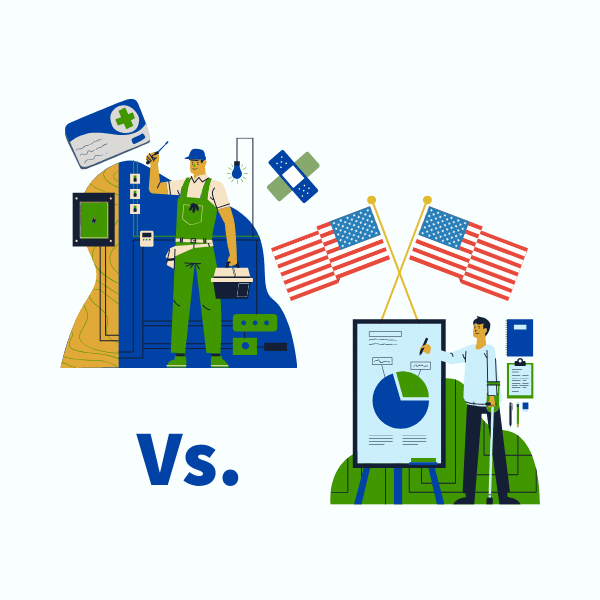Obamacare and Trumpcare
Medical care and health insurance rules and regulations have long been confusing in the United States, and the differences between Trumpcare and Obamacare have only fueled the debates between politicians and the frustration that the average American feels. Many no longer know what type of insurance they are required to have, whether they will be penalized for not holding insurance and which legislation most helps them. Others have no idea whether or not Obamacare has been repealed. Rather than giving up on trying to figure out what ACA, AHCA, Obamacare and Trumpcare mean on your own, consult this handy guide to find out information about the following topics.
- What are the differences between Trumpcare and Obamacare?
- What is AHCA vs ACA?
- What are the pros and cons of Trumpcare vs Obamacare?
- What changes have the American people experienced with Trumpcare?
What Is Obamacare?
Obamacare is the familiar name for the Patient Protection Affordable Care Act (ACA) that was passed in 2010 under the administration of President Barack Obama. While the term “Obamacare” was originally meant as a disparaging term that was created by opponents of President Obama, it has come to be a catch-all term for the health care reform of that decade.
The Affordable Care Act was originally put in place to help Americans more easily afford their health care. It was designed to make health care less expensive across the board and to get health insurance into the hands of all those who needed it. In fact, a main component of Obamacare was a requirement for health insurance for everyone. Those who did not hold this mandatory health insurance would be subject to a hefty tax penalty when they next filed their federal income taxes.
Obamacare also had several other key features. First, it stopped insurers from limiting coverage for pre-existing conditions while also providing subsidies for those at the lowest income levels to help them better afford the cost of medical insurance. This was particularly important as insurance prices rose considerably after the passage of the ACA.
Second, it created a Medicaid expansion, increasing coverage for individuals whose annual income fell below 138 percent of the Federal Poverty Level. However, two years later, the Supreme Court ruled that this expansion would be optional for states. Today, there are only 14 states that have decided not to expand their Medicaid programs with the assistance of the federal government.
Third, Obamacare set up several important health insurance exchanges or marketplaces, which are Websites where individuals can search for medical insurance plans based on tier levels and apply online. Yearly open enrollment gives individuals a chance to shop the exchange for a new plan and to compare costs.
Finally, Obamacare ruled that all ACA health insurance plans must provide 10 essential benefits to those who are insured. These include such important care options as wellness visits, maternity and newborn care, mental health treatments, prescription drugs, hospitalization, outpatient care and emergency room services among others.
What Is Trump Obamacare, and What Changes Did AHCA Bring?
Although Obamacare was first enacted to make basic health care more affordable for many Americans, numerous people were dismayed at the many changes it brought to their lives. Some did not want to shop on the federal government’s health insurance exchange or apply for tax credits to help them afford their insurance premiums for fear that the government would become too involved in their lives. Others were astounded at how high health insurance premiums were rising because of the many people with pre-existing conditions who now were required to hold insurance. Although the benefits of preventive care and essential health services were great, they did not offset the downsides that many Americans saw. For this reason, numerous citizens sided with Donald Trump when he ran for office in 2016, vowing to repeal Obamacare.
While President Trump did not succeed in totally repealing the ACA, he did succeed in pushing certain changes through Congress. Through a long series of bills and discussions that ended in a tie-breaker vote from Vice President Mike Pence in the Senate, the American Health Care Act (AHCA) was passed in July 2017. Although many parts of Obamacare remain in place with the AHCA, there are several key changes that aimed to make the requirements of following the law easier for average Americans.
One of the key changes with AHCA, now commonly called Trumpcare, is that Americans are no longer fined on their federal taxes if they did not hold an appropriate health insurance policy throughout the entire prior year. However, taxpayers are still supposed to hold individual health insurance policies or health insurance policies through their employers. In addition, there are still tax credits available for individuals who shop for health insurance on the federal government’s exchange. Keep in mind that some states have opted to continue non-compliance penalties. These states include New Jersey, Massachusetts and the District of Columbia.
For the millions of Americans who receive Medicaid, a type of social welfare plan designed to help low-income families, seniors, disabled adults and more receive adequate health care, changes from Trumpcare can affect the benefits they receive. AHCA reduced the amount of funding for Medicaid at well over $800 billion over 10 years. This could lead to a significant lack of compensation for doctors and health care facilities.
A final major change with Trumpcare was that more short-term health insurance plans came onto the market. However, these plans do not have the same federal requirements that those sold on the government-run exchange during open enrollment season do. Instead, they can limit coverage dramatically to individuals with pre-existing conditions. While the premiums for these short-term plans are quite reasonable, they certainly do not cover as much as ACA-compliant plans do.
Advantages and Disadvantages of Obamacare
After years of discussions over the inadequacies of health insurance and health care costs in America, the advantages of Obamacare passage in 2010 were sizable. After the Affordable Care Act was passed, millions more Americans could finally get the health care coverage they needed and could find coverage for the most important parts of health care, including preventive and ambulatory services. Some of the other advantages of Obamacare include the following:
- Individuals have more health insurance options.
- Americans with low incomes can take advantage of tax refunds to pay for health insurance.
- Insurance companies are required to put at least 80 percent of the money they make on premiums back into health care and insurance improvements.
- Individuals with preexisting health conditions can find full health insurance coverage.
- Caps on health care coverage were removed.
- Important health care screenings and wellness visits are covered.
Despite all these positives, there are certainly some disadvantages of Obamacare as listed below.
- Many Americans have higher insurance premiums than they once did.
- Many Americans have had to choose high deductible health insurance plans to afford their premiums.
- Americans who do not hold health insurance were fined.
- The United States needed higher tax revenue to pay for the ACA.
- Some have seen their Obamacare coverage canceled mid-year for no reason.
Advantages and Disadvantages of Trumpcare
Because of the problems with Obamacare, many lawmakers sought changes to ease the financial burden on the American people and to increase their ability to choose the type and amount of insurance coverage that they wanted. For this reason, many have seen numerous advantages of Trumpcare over the older model. People feel more freedom to make their own insurance choices. While President Trump and Republican legislators have not been able to make all of the changes that they had originally proposed, some changes have been put into place. The biggest advantages of Trumpcare include the following:
- Americans are not fined for not holding health insurance the previous year.
- Insurance providers can provide services across state lines.
- The tax burden for major businesses has been reduced.
- Individuals can buy policies that do not cover all essential benefits if they do not need them.
- Many of the positive portions of Obamacare were kept, giving individuals options for purchasing plans that did provide all 10 essential benefits.
- Short-term health insurance plans have been made available.
While the decision not to fine individuals and families who did not fulfill the health insurance mandate the previous year has certainly provided welcome relief to millions of Americans who previously had to pay hefty fines, there are still many disadvantages of Trumpcare.
- Individuals with the lowest incomes still suffer with worse health care coverage.
- Healthy people may not feel any incentive to get health insurance, thereby making premiums higher for those who do.
- Employer health insurance mandates were removed.
The Bottom Line with Trump Obamacare
President Donald Trump has made it his mission to repeal the Affordable Care Act entirely, but so far he has not be able to do this. Instead, Trumpcare vs Obamacare battles remain pitted against each other with Trumpcare working to undermine some of the less positive changes of Obamacare. It is more important than ever that American citizens understand what the requirements of the law are and how AHCA vs ACA changes affect them in each coming year. Thankfully, the majority of changes have aimed to keep the most positive parts of the ACA in place while easing the financial burden on average Americans.
There are many hurdles that millions of Americans must clear to get the right amount of health insurance coverage for their needs. For some Americans, paying for insurance premiums still remains incredibly burdensome. For others, they have found that shopping for the right insurance plan on the health care exchange has made their lives during open enrollment season so much easier. Others are still confused as to what type of insurance they are required to carry or how they can apply for tax credits.
Increasing changes are sure to continue coming over the years as Americans elect lawmakers who match their own idealogical principles. For the moment, Obamacare has still not been completely repealed, and yearly changes to health care and insurance laws are aimed at improving health insurance coverage, overall freedom for the American people and health care delivery across the country.



Exchange Healthcare News
As the Affordable Care Act creates millions of new health insurance customers and provides new options for the already-insured, confusion about basic insurance concepts could make it difficult for people to make the right choices.
About 33 mins ago